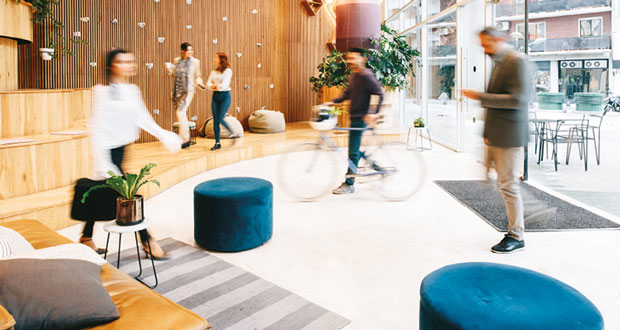 Demystifying different workstyles that have emerged over the past two years is vital for post-pandemic organisations to thrive, says Giles Fuchs, CEO of Office Space in Town (OSiT)
Demystifying different workstyles that have emerged over the past two years is vital for post-pandemic organisations to thrive, says Giles Fuchs, CEO of Office Space in Town (OSiT)
As employees increasingly return to offices, many companies are rightly asking themselves what exactly the future of work holds. In the two years during which the majority of people worked from home, we have learned important lessons: we are social creatures that thrive off in-person interaction and many of us are more productive and happier working collaboratively in an office. However, our working behaviours and office environments must adapt to a post-pandemic desire for flexibility and high-quality spaces.
So, as we tip-toe towards a new normal, companies must make the most of the new opportunities to re-engage remote workers, to rethink the very nature and purpose of the office. Understanding the different working styles that have emerged will be vital to this.
HYBRID WORKING
The concept of hybrid working was popularised during the pandemic. It is often confused with flexible working but actually refers to how an employee splits their time between working in the office and remotely – which may be from home or satellite offices or even coffee shops and flexible working spaces.
Anecdotally, it seems to be how most companies and employees see the return to work happening, at least initially. Although how companies choose to implement the model varies enormously.
For employers, hybrid models can offer an answer to some of the negative issues of permanent home working like a loss of productivity, isolation and mental health issues. But they aren’t right for every situation. Many work interactions require people to be face-to-face more often.
For example, the best creative work happens when a team is in full flow and everyone is focused on solving a collective problem. That is best done when teams are together in the same space. For situations like this many companies have implemented activity-based working.
WHAT IS ACTIVITY-BASED WORKING?
The idea here is that employees are more productive when they have the right spaces in which to complete certain tasks. And, as the name suggests, it allows people to choose their work setting based on what they are doing at a particular time.
While this sounds like a great solution it is not without challenges. Some of the amenities which are being expected by businesses include: entertaining spaces, breakout areas and even recording studios to accommodate a variety of activities such as client meetings, team brainstorms and even podcast production. For high quality office buildings this is the standard, but others are being left to catch up.
Another challenge this presents is dealing with different levels of occupancy, as some spaces will be used more than others, and some days of the week will inevitably see greater footfall. But, if these challenges can be overcome, the result will be a boon for workers and businesses.
“SEMOB” WORKING
Perhaps a fundamental question underlying all this is, what is the office and what purpose does it serve?
Historically, the office was somewhere you went to work and then went home. But the nature of work and how we do it has changed fundamentally. The modern working day balances social activities and time to use services that aren’t available to us during our leisure time.
To accommodate this the office is evolving beyond its traditional functions as a mere workspace. At OSiT, for example, our Service-Enhanced, Multi-Occupancy Buildings (SEMOB) aim to provide a service alongside a space, and the possibilities are almost endless.
Office spaces could include everything from gyms and shops to doctors surgeries, dentists, hair salons and more. In recognition of how people are increasingly travelling for work and important meetings, our Monument centre includes bedrooms, ideal for stopping over after important meetings or simply late-night social events.
The SEMOB model reflects the move to a more holistic working environment. It is important to recognise that professionals travel to the city centre for more than just work, so a space which prioritises convenience and actively meets the needs of occupiers will be popular with both employees and businesses.
NAVIGATING DIFFERENT MODELS
The pandemic has taught us many things. We have learned how much we value time with our families and the time to do things we really love. But, it has also taught us that workplaces are vital to many efficient work practices and to worker wellbeing, as well as being an important driver of economic activity in cities.
This evolving discussion on the work environment reflects a real need for businesses to take the changing priorities of their employees into consideration. Making informed decisions about work strategies will be essential for a stronger business and workforce.
And, while the adoption of new work styles and settings present unique challenges, there is an exciting opportunity for companies to reimagine how they want to engage with their employees and the spaces they share.





